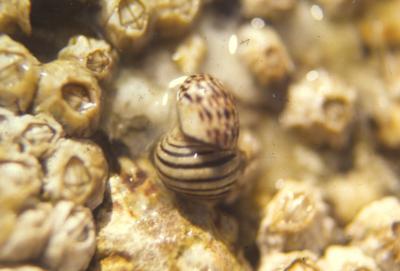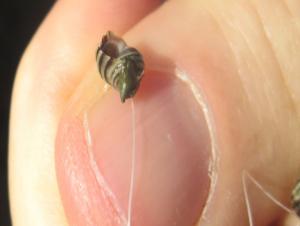Insights into snail size as a 'magic trait' for speciation
Predator-driven selection has been shown to cause the evolutionary change in prey populations. A newly published paper shows evidence that selection by a predatory crab may be responsible for ongoing speciation of the marine snail Littorina saxatilis. In Northern Spain L. saxatilis has evolved into two ecotypes (genetically distinct population within a species): crab-resistant and wave-resistant.
As their name suggests, the large crab-resistant ecotype has a thick shell and lives in the upper intertidal zone while the small wave-resistant ecotype has a thin shell with a wide aperture and lives in the lower intertidal zone. Breeding experiments have shown that the size and shell characteristics are highly heritable. Mate choice experiments have shown that the two ecotypes will mate but that there is a strong preference for mates of similar size.

Larger, thicker-shelled, upper shore crab ecotype of L. saxatilis on the left VS. the smaller, thinner-shelled with a large aperture ecotype of L. saxatilis on the right
Prof. Elizabeth Boulding and her Spanish colleagues set out to test whether this snail’s shell size is a ‘magic trait’. A ‘magic trait’ is a trait under divergent selection in different habitats that also acts as a mating cue. By reducing gene flow from one population to another, thus facilitates ecotype formation.

Mating pair: crab ecotype female on bottom and wave male on top
Two sets of both laboratory and field experiments comparing two prey classes of snails were conducted to test their hypothesis that the larger and thicker crab-resistant ecotype would be less vulnerable to predation by the marbled shore crab, Pachygrapsus marmoratus.
Crab and wave ecotype snails in front of their predator, the marbled shore crab
While in the lab it was easy to control and observe predation preferences by presenting different sizes of marbled shore crabs with different sizes or ecotypes of snails, the field experiments were trickier. To ensure that the crabs could have access to different prey classes, they glued fishing lines to live snails and then tied them to screws. After a few days they returned to the shore and examined whatever was left at the end of each line: either a live snail or a shell fragment characteristic of crab predation.

Fishing line glued to the snail for experiments in the field
All their predation experiments showed that most of the crabs (other than the ones with the largest claws) were only able to consume the smaller class of the crab-resistant ecotype. All crabs showed a strong preference for the wave ecotype and took them less time to break open its shell. They also found almost no predation on the lower shore characteristic of the wave ecotype.
They also showed that the two ecotypes had significantly different shell and life-history traits. The wave ecotype had significantly thinner shells and shape, they used the spaces between mussels in the low intertidal zone as a refuge from waves and they were sexually mature at a much smaller shell length.
Their work adds to previous studies showing that predator-driven selection can drive ecotype formation and supports their hypothesis that shell size is a ‘magic trait’ in L. saxatilis; size acts as an important barrier to gene flow because of mate choice and because of selection for large size on the upper shore and small size on the lower shore. Therefore size plays a key role in the divergent evolution of the species.